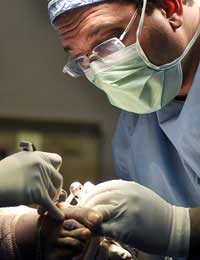Cosmetic Foot Surgery

Deformities like bunions and hammertoes are the main reason why surgery procedures on the feet are undertaken. These deformities can cause a great deal of discomfort as well as create further joint pain and corns when the feet are squeezed into shoes that are no longer comfortable to wear. A corrective procedure is undertaken to provide better comfort and relief and also improve the general appearance of the feet.
Common Corrective Procedures
The most common foot deformities are bunions, hammertoes and overlong toes. All these can be corrected by cosmetic foot surgery procedures. Ingrown toenails can also be easily corrected with a nail surgery procedure. Morton’s Neuroma – swelling of the nerve in the foot – can be treated using cortisone injections or with neurectomy, which is a surgical procedure that removes the diseased portion of the nerves.Surgical Procedures
A surgical procedure to shorten overlong toes takes about 15 minutes per toe under local anaesthesia, as an outpatient. During this time removal of a portion of the toe’s small joints takes place and bone pins or screws are then inserted. The healing period for this kind of surgery is about three to six months, although new toe alignment is assessed and evaluated directly after surgery.Arthroplasty
The construction of a new moveable joint is known as arthroplasty. This procedure is used on the metatarso-phalangeal joints in the foot and is part of the treatment for hammertoes and mallet toe deformity. A small piece of the bone is removed from one side of the toe joint and repaired by interposing the capsule and tendon into the joint. This stabilises the toe and improves appearance, although there may be swelling for a few months.Recovery Period
After most forms of foot surgery the patient will be able to walk with the use of crutches for at least a week. The wearing of special surgical shoes is recommended, as too is the changing of dressings after seven days. Suture removal generally takes place two weeks post surgery.Pain relief medication is prescribed for the first few days after surgery. To ease further discomfort ice packs can be applied and as much elevation of the feet as possible is also a good idea.
Gradual walking, a few days after surgery, will help mobility and flexibility, but comfortable, roomy trainers should be worn for the first few weeks. Any scarring can be treated with scar-care products but this will be discussed with the surgeon after surgery.
Risks and Complications
As with all cosmetic surgery procedures there is always an element of potential risk. When researching surgery options you will be provided with information regarding all types of risks and possible complications so that you are able to make an informed decision about surgery.The most common complications are the risk of infection of the soft tissues, which is treatable with antibiotics; swellings that take longer than expected to reduce; and severe pain. It is rare, however, for a patient to develop Complex Regional Pain Syndrome – which requires treatment at a specialist pain clinic.
- How to Reduce Cankles
- Anointing Oil for Feet
- Baby Foot Casting
- Foot Care After Surgery
- The Art of Foot Reading
- Reflexology Self Treatment
- How to Take Better Care of Your Feet
- Rough Feet Homemade Remedy
- Winter Foot Care
- The Benefits of a Paraffin Wax Treatment
- Athlete's Foot: Natural Remedies
- Five Steps to an Easy Pedicure
- What is Ayurvedic Footcare?
- Backpacker's Foot Facial
- Acupuncture for Feet
- How to Choose a Podiatrist?
- How to Give a Therapeutic Foot Massage
- How to Give a Home Pedicure
- Walking Socks and Liners
- How to Use Nail Clippers Effectively
- How To Treat Haglands Heel Bumps
- Sport and Foot Problems
- Establishing a Good Foot Care Routine
- Foot Surgery
- Preventing and Treating Cracked Heels
- Feet and Flying
- Guide to Children's Shoes
- Combating Foot Odour
- Preventing and Treating Hard Skin
- Pedicures
- How Reflexology Works Using the Feet
- Podiatry and Chiropody
- Insoles and Orthotics
- Pregnancy and Feet


Re: Footcare and the Housebound
My dad is housebound due to 5 major strokes. He walks with a walker and wears a foot splint. The splint is old, heavy and no longer…
Re: Supportive Feet Products for Senior Citizens
I have a prescription from Dr. at OHSU, but I need some lab to make the Orthodic insoles for my shoes. I was…
Re: How to Get into Foot Modelling
I am female 32yrs of age.I am from south africa I would like to enter into feet and hands modelling industry .I know and I…
Re: The Benefits of a Paraffin Wax Treatment
Hi! Does it cure sweaty palm and feet too?
Re: I have Sharp Pains in My Foot, What could it be?
Recently I have been experiencing a stabbing pain in my left foot,its on the bottom at the back. When I…
Re: Fungal Infections of the Foot and Toenail
I have a constant problem with intense itching on my feet which erupts daily, especially when my feet get warm…
Re: Cosmetic Foot Surgery
I have extremely sweaty feet and it seems to be getting worse. I have perspirex, but it doesnt help. Please help, I don't know what to do…
Re: The Benefits of Foot Massage for Children
One day I came home and my wife said our younger son was having trouble concentrating on his homework. I asked…
Re: Cavus Feet: Symptoms, Causes and Treatments
@sue - I am sorry to hear this. As suggested in the article, arch supports or orthotic devices may be used to…
Re: Cavus Feet: Symptoms, Causes and Treatments
My daughter has cavus feet and has had surgery a few times already. Her surgeon has dismissed her and she is…